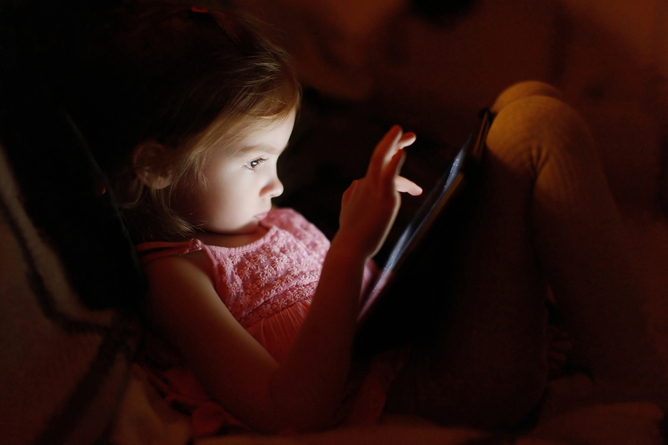
Is it OK to Give Your Baby that iPad? (Op-Ed)

This article was originally published on& The Conversation. The publication contributed this article to Live Science's Expert Voices: Op-Ed & Insights.
A recent New York Times article points to a glaring inconsistency between the amount of “screen time” toddlers have using tablets, phones and computers – and the advice of many early years specialists.
In fact, there are several apps specifically developed for (and enjoyed by) two-year-olds and even one-year-olds, yet the official guidance from the American Paediatric Association states that: “Television and other entertainment media should be avoided for infants and children under age two.”
So why is the age of two a milestone that matters? I asked a few of my early childhood specialist European colleagues about the policies in their countries. In Germany, some child psychologists advise that screen use should be avoided until the age of six, in Finland and other Scandinavian countries there is no consensus, in Spain and Poland, practitioners typically refer back to the APA guidance of two years.
They all pointed out that lumping together watching television, essentially a passive activity, with interactive and participatory use of smartphones, tablets, video game consoles, Leapsters (educational toys combining video game and physical activity) seems absurd. It seems that, somewhat ironically, despite the global market for such technology we are far from reaching a global consensus on what is and isn’t appropriate screen use at different ages.
There is a lot of guidance on establishing the appropriateness of screen time overall, for example the recent RAND report outlined five key questions for parents and teachers to consider. Lisa Guersney, a writer on early years education, has pointed to the importance of content, context and the individual child.
Might it be that children under the age of two are too young to understand the content and context of what they see on screens?
Sign up for the Live Science daily newsletter now
Get the world’s most fascinating discoveries delivered straight to your inbox.
Comparing two worlds
Screens are essentially a surface that creates and contains an alternative world. So we need to think about the concepts displayed in this “other world” and ask whether children under two might not be able to grasp them in a way that would have a meaningful, and positive, impact on their development.
For example, it’s well-established that despite being only six months apart, three-year-olds consistently outperform two-and-a-half-year-olds in dual representation tasks, designed to test children’s ability to imagine the relation between a symbolic and a real representation of the same object.
Research by Judy Deloache and colleagues shows that some young children also make scale errors, for example mistaking toy cars for real cars. (If you don’t have a baby to test this on you can see for yourself from videos at the Child Study Center of University of Virginia.)
Child psychologists also know that interactive apps can interfere with children’s story comprehension, mostly because the parents reading the book to their child tend to focus more on the interactive elements than on the story, something that wouldn’t happen with a printed book.
No matter how accurate and personalised language-teaching software might be, it can never deliver the range and quality of linguistic cues of a human speaker. The ability to try mimicking and mirroring facial expressions, gestures, tones of voice and body language is crucial for early language development.
Content matters
Technocrats might argue that given the popularity of tablets with both adults and young children, they could serve to bring both together. But the quality matters – typically print books go through a competitive peer-review process, often with early-years experts advising on quality before publication. The App Store Review Guidelines for Kids are remarkably short by comparison, and certainly not informed by the work of child psychologists.
The one-sided portrayal of the world in children’s software is another important consideration. Adults and friends model various complex behaviours, including not to rely on digital devices in all situations. Needless to say, this cannot be modelled by an app.
One could argue that not all software for the under-twos is there to be educational or to support their development. Many apps are simply to entertain parents and children alike. However is such hardware appropriate for babies’ entertainment? Has anyone actually tested what the different levels of screen brightness do to the developing eyesight of children?
Physical vs digital
Similarly, we know very little about the possible long-term effects on the under-twos of extended interaction with touch-screens. Moving, highly interactive and responsive images have distinctively different properties from most other objects with which toddlers interact.
Touch is the first and number one means of communication and learning in early childhood. They need to be able to manipulate, squeeze and chew on things to understand their basic properties. We have no idea what happens if we substitute the time spent on these experiences with the variations used with digital tech such as tapping, swiping, dragging and dropping.
So what’s the verdict? In an age of ubiquitous screens, it’s simply not possible to avoid them completely. Parents should certainly not panic when their baby encounters a screen, especially if it is at an opportune moment for parent and child to do something together. But until we have research-driven evaluation criteria for the appropriateness of screens for under-twos, it is best to minimise their presence and to maximise that of effective human contact.
Natalia Kucirkova receives funding as a KTP Associate. She is affiliated with The Open University and Booktrust.
This article was originally published on The Conversation. Read the original article. Follow all of the Expert Voices issues and debates — and become part of the discussion — on Facebook, Twitter and Google +. The views expressed are those of the author and do not necessarily reflect the views of the publisher. This version of the article was originally published on Live Science.









